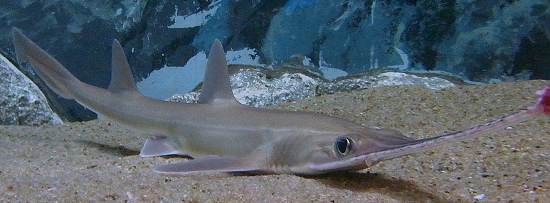The Saw Shark Family
Pristiophoridae
Members of the Saw Shark family are some of the oddest looking sharks out there, but how cool is that long toothy snout?
It's like having your own built-in light sabre. Well, maybe not quite that cool. Ooh but imagine if it was bioluminescent. No? Okay, here are some facts then.

The family consists of 10 species in 2 genera.
|
|
These sharks are easily confused with sawfishes which, though similar in
appearance and distantly related, are actually batiod fish, or rays.
The
simplest way to tell the difference between the two is to look for the
barbels. These are two whisker-like sense organs which project from the
sides of the rostrum (saw) of the sawsharks, but not the sawfish.
Okay,
so you're probably not that comfortable getting up close and personal
with the sharp bits so how else can you tell? Read on and we'll compare.
Saw Shark Characteristics:
- General body shape - Both the shark and the batiod have flattish heads and long snouts with scary looking teeth. So not much help there then. The body of the shark is slender and cylindrical.
Sawfish get much bigger than the sharks which grow to an average length of about 150cm. The largest sawfish gets to about 7m.
- Eyes - The eyes of the sawsharks are on the side of the head and spiracles are present. Sawfish have poor eyesight but, unless they're wearing glasses, I guess that won't help you to distinguish them from the sharks.
- Teeth - Like other shark species the teeth on the saw sharks are replaced when they're lost. Sawfish, on the other hand are like us - look after them or lose them forever.
The teeth on the shark differ in size too. They alternate between one short tooth and one longer one giving them a sort of crazy living chainsaw sort of look. Sawfish are neater looking with similar sized teeth all the way up the rostrum. - Gills - The genus Pristiophorus have five pairs of gill slits and the single member of the genus Pliotrema has six.
The gill slits in the sharks are on the side of the head whereas the sawfish has them underneath like a ray. - Fins - Saw sharks have two spineless dorsal fins, a pair of pelvic fins and a pair of dorsal fins. Unlike the sawfish the pectoral fins are not fused to the head.
The caudal fin has a long upper lobe but no lower lobe and the anal fin is absent.
The African Dwarf Sawshark is a new species discovered when one was caught in deep water off the coast of Mozambique in 2011. It's always exciting when a new species turns up.
We'll have to do some research and find out a bit more about it so we can get his page written up as soon as possible.
Return to World of Sharks from Saw Shark

Longnose sawshark

Shortnose Sawshark
Recent Articles
-
Thresher Sharks
Aug 27, 14 10:51 AM
Thresher sharks are unmistakable with that huge upper lobe on the caudal fin. Let's find out more about them. -
Sharkwater
Aug 14, 14 12:42 PM
Sharkwater is a documentary by Rob Stewart highlighting the plight of the sharks in our oceans. -
Natural Cleaners
Aug 13, 14 08:57 AM
Natural cleaners and homemade skincare products are not only better for the environment, they're better for you and your family.
